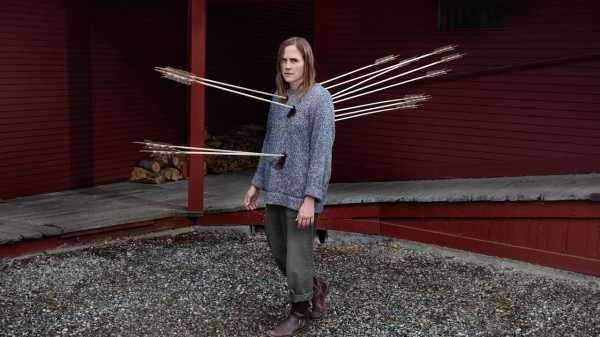
One morning, this past fall, Jeremy Dennis, a thirty-two-year-old photographer, set out from the southern tip of the Shinnecock Indian Reservation, on the east end of Long Island, to make a picture of a neck of land called Sebonac, on the southeast edge of the Great Peconic Bay. The picture was to be the latest in a series that Dennis, a Shinnecock citizen, began in 2016—photographs made in and around his home on Long Island, entitled “On This Site.” “The Algonquin place name for that region is Sebonac,” he wrote in an e-mail. “I often refer to William Wallace Tooker’s 1911 ‘Indian Place-Names on Long Island’ for history but the translations are often wrong or guessed.” The guessed-at and possibly wrong definition of Sebonac is something along the lines of “groundnut place,” but sources identify it as a site that the Shinnecock community visited often to harvest food, a place that, even after white settlement began in the sixteen-hundreds, the Shinnecock people continued to use.
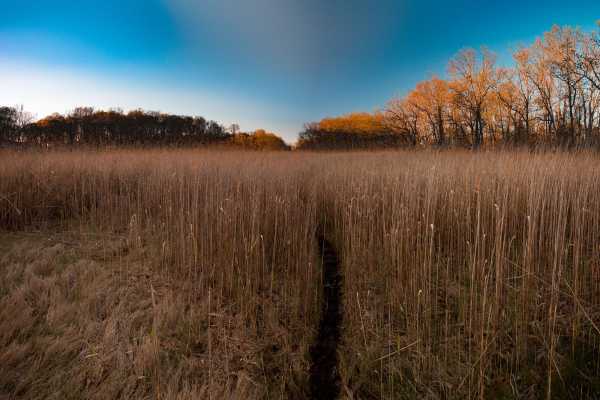
“Chepiohkomuk-qut, Solecki Site Cutchogue,” 2018.
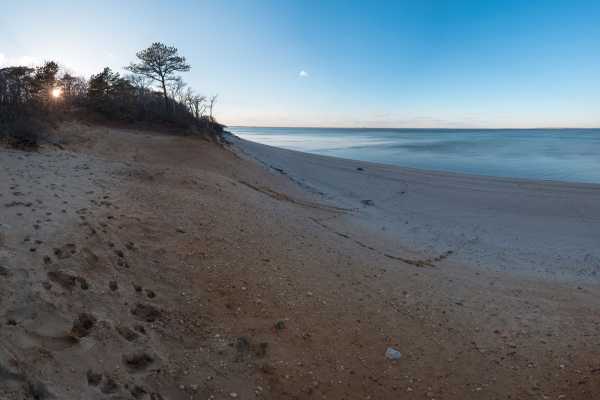
“West Woods,” 2018.
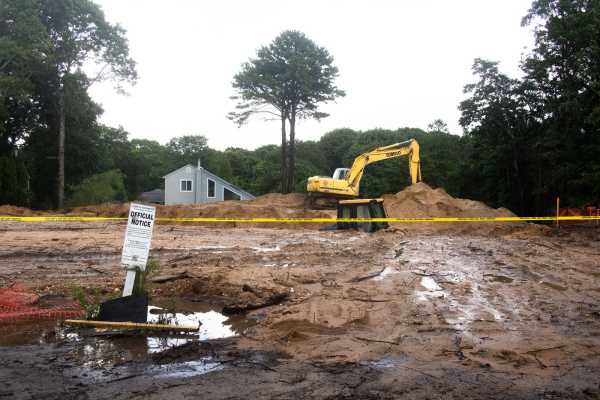
“Hawthorne Road,” 2018.
In his gray Honda Accord, Dennis drove us out of the thick coastal woods that make the reservation feel like a less-developed version of Cape Cod. We turned onto the area’s main highway, and then, at the Mercedes-Benz dealership, turned north, passing manicured lawns and mostly hidden swimming pools. A phone call came in—a request to collaborate. Dennis’s fine-art photography is in high demand nationally; images from another of his series, “Nothing Happened Here,” which imagines Indigenous warriors rising in the landscape of contemporary America, were featured last year in the Amon Carter Museum’s exhibition of Native American photography, in Fort Worth, Texas. He is busy locally as an organizer. On the Shinnecock Reservation, he runs a residency program for young BIPOC artists called Ma’s House, whose name was inspired by Dennis’s grandmother. In the car, while on speakerphone, he was discussing an Indigenous film festival he had organized for the following weekend, in Sag Harbor, featuring short films by Cherokee and Passamaquoddy directors, as well as Dennis’s own documentary on his renovation of Ma’s House during the COVID lockdown.
Denise Silva-Dennis is featured in the film. She is an artist, a former Southampton Elementary School art teacher, and Jeremy’s mother. “One day,” she says on camera, “Jeremy came up with the idea: ‘What do you think of making Ma’s House into a residency? Invite other artists in, just keep our culture alive?’ ”
When the call ended, Dennis studied his dashboard G.P.S., trying to find the best access to the site he was aiming to photograph. We pulled down what looked like a small public road but were soon greeted by a gate that read “No Trespassing.” We backed up, headed along the edge of the now mostly filled-in Sebonac Creek and, as we came around a wooded bend, turned out into the light of Bullhead Bay. Dennis pulled over and got out of the car. He was looking for an aerial view to photograph using a drone. He opened his trunk and began fidgeting with the device.
Across the road was the National Golf Links of America, three hundred acres of links-style golf, designed in 1908, and I wondered if the golfers would ask what Dennis was up to. He worked calmly, fiddling with some software, then launched the drone, steering it up over the bay, while managing the controller, studying the screen intently for his picture. “We’ll see if they come over here,” he said.
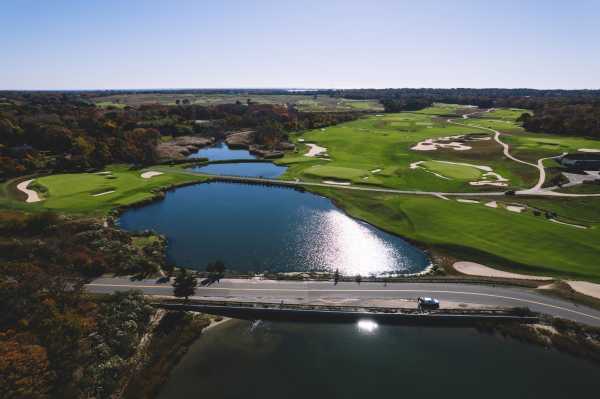
“Sebonac Site,” 2022.
“On This Site,” which documents places that are important to Native American history along Long Island, takes its inspiration from a project of the same name by the photographer Joel Sternfeld. Between 1993 and 1996, Sternfeld photographed the locations of often notorious historical incidents, quiet explorations of America’s intrinsic violence. On Long Island, Dennis has made just over two hundred site photographs so far, the images mesmerizingly straightforward and almost banal, in the manner of nineteenth-century survey photos. The locations range as far east as Brooklyn. In Cobble Hill, a site Dennis photographed was known to the Canarsie tribes as Werpos, mentioned in the writings of Willem Kieft, the director of New Netherland, dated May 27, 1640: “For a certain peice [sic] of land upon the Long Island near Merechkawikingh about Werpos.” The early nineteenth-century writers, though at odds over the term’s definition, see Werpos as a village site that was abandoned after the so-called sale of Manhattan to the Dutch.
Most of the pictures have been made on the eastern half of Long Island, in and around the Hamptons, which—to the surprise of a good number of Hamptons visitors—is where the Shinnecock Nation is situated, on nine hundred acres, with fifteen hundred members, about half of whom live on the reservation. Mecox Bay, for example, which Dennis photographed during a 2019 snowstorm, is the point on the Bridgehampton shoreline where, in a winter storm in 1876, the freight ship Circassian was wrecked just offshore. “Ten members of the Shinnecock tribe were among those who drowned,” Dennis wrote in the notes on his photograph. A picture entitled “Horse Barn Burial Site” was made on Shelter Island, where, in 2003, a group burial plot was discovered during the construction of a horse barn. Archeologists dated the burial to between 1400 and 1640 A.D. “Shinnecock tribal members argued against further disruption of the soil, seeing the proposed barn as a cemetery site,” Dennis wrote. “Despite resistance, the private owners continued development while the remains were reburied in an undisclosed location on Shelter Island.” Dennis’s picture is a panoramic view of the little hilltop site, a white fence surrounding a few horses, a barn in the distance.
Dennis posts the pictures on an interactive map that has become a resource for teachers and students. “A lot of people use this for land acknowledgments,” he told me. The Web site gets about seven thousand views a month. “The Web site is very delicate, and it will go down sometimes,” he said. “There’ve been a lot of funny instances of a social-studies teacher calling me and saying, ‘It’s not working. What’s going on?’ ”
It’s also used by local officials—including Jeremy’s sister, Kelly Dennis, a member of the Shinnecock Council of Trustees—in protecting sites of traditional importance to the tribe. Kelly was appointed last year as Eastern Regional representative to Interior Secretary Deb Haaland’s inaugural Tribal Advisory Committee, which comprises tribal representatives chosen from across twelve regions in the U.S. “I am a lawyer,” Kelly said, “and I’m trying to figure out the legal theory and history behind things.” “On This Site” has become a de-facto tool in aiding members of the Shinnecock community in their work to preserve burial sites, which suffered a recent setback on the state level. In December, Governor Kathy Hochul vetoed the Unmarked Burial Site Protection Act. The defeat in Albany came despite successes in the Hamptons. In 2020, the Southampton Town Board passed the Graves Protection Act and the Shinnecock Hills Building Moratorium, and, in 2021, Sugar Loaf, a hilltop burial site in the Shinnecock Hills, about a mile and a half south of Sebonac, was purchased by the Peconic Land Trust. The seven-thousand-square-foot house on the hilltop was demolished. “A glimpse of what the future may look like, I hope,” Shane Weeks, a member of the Shinnecock Graves Protection Warrior Society, said to the East Hampton Star. “Sugar Loaf was probably the first place I photographed,” Dennis told me.

“Sugar Loaf Hill Site,” 2022.
The first time I met Dennis, in 2019, he was taking down a show at the Patchogue-Medford Library; a sampling of the “On This Site” photos continually tours libraries and museums on Long Island, the pictures accompanied by small site histories. “Just going back to the demographics of how small a community we are,” Dennis said, “when we put this information out for free, you just get allies—like, if they can read, they can agree.”
For another ongoing project, called “Stories,” Dennis stages North American Indigenous myths using the clothing and adornments of Northeastern tribes—those in New York State, like the Long Island tribes and the tribes of the Haudenosaunee, as well as those of the Wabanaki Confederacy, whose territory includes coastal New England. He does so by overlaying images of humans or humanlike creatures on landscape photographs, setting the stories in the places they are told. He uses digital-illustration techniques to bring alive old accounts, to make what Corinne Erni, the curator of special projects at the Parrish Art Museum, describes as “hyperrealistic, cinematic photographs.” The Parrish recently acquired “The Stone Coats,” which depicts an Iroquois tale of rock creatures who competed with humans for game. (It is also featured in an exhibition at the M.T.A.’s Atlantic Avenue–Barclays Center Station in Brooklyn, along with other works from “Stories.”) In 2018, Erni programmed Dennis’s first major solo exhibition at the Arts Center at Duck Creek Farm, situated in East Hampton on Squaw Road, a street name Dennis calls “pretty messed up.” He wrote to the roads department, asking that the name be changed. “They never responded,” he said. Duck Creek Farm now links their land acknowledgment to Dennis’s “On This Site” project.
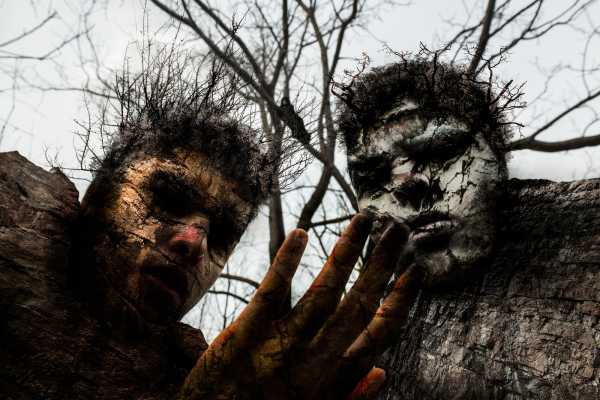
“The Stone Coats,” 2014.
“Stories” grew out of Dennis’s work while he was a student at Stony Brook University, where he majored in studio art and was enamored by Albrecht Dürer’s woodcuts, images depicting Biblical texts. At first, Dennis made intaglio prints of Native American stories, but slowly he moved to photography, which he had always loved—his sister remembers him hijacking his parents’ camera when he was a boy, his surreptitiously made pictures surprising the family when the developed film returned home. In 2016, just before graduating with an M.F.A. in photography from Penn State, he won a grant to begin “On This Site,” from Running Strong for American Indian Youth. The fund supports Native American projects and was created by Billy Mills, the Oglala Lakota runner from Pine Ridge who, at the 1964 Olympics in Tokyo, came from behind to win the gold medal in the ten-thousand-metre race.
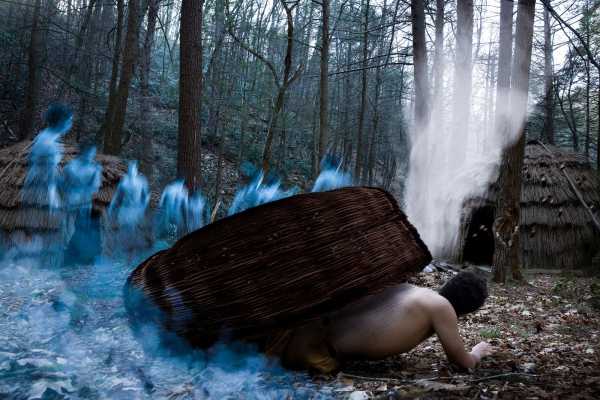
“Dance of the Dead,” 2014.
At grad school, Dennis’s mentor was Lonnie Graham, an artist and instructor whose own photographic work explores the relationship between art and community building. “A social activist can work with the community the way that a painter works with a color palette,” Graham told me. Graham coached Dennis in envisioning a practice that functioned in concert with the needs of the Shinnecock nation, where the median income is thirty-thousand dollars, in contrast to the wealth surrounding it: in the Hamptons, the Shinnecock have long been ignored or tolerated, even after the tribe was recognized by the U.S., in 2010. “I think it’s important to tell artists that they have an important voice and role in society,” Dennis said. “Just being able to use that voice to critique and look at things differently is what I think artists have been doing for thousands of years.”
The project that is most likely to make a golf-course security guard wonder about the five-foot-nine-inch-tall guy in the red hoodie flying a drone out of the trunk of his gray Honda is referred to by Dennis as “Nothing Happened Here.” The title is ironic, to put it mildly, and the images feature people who volunteer to pose, or who accept Dennis’s invitations to be photographed. He has described the works as “stylized portraits of non-indigenous people impaled by arrows [that] symbolize, in a playful way, the white guilt many Americans have carried through generations, and the inconvenience of coexisting with people their ancestors tried to destroy.” In one of the most frequently reproduced images, a man sits on wooden stairs, in shorts and a plaid short-sleeve shirt, looking blankly into the distance, arrows impaling his chest and right shoulder. In an image featured in Quebec’s Contemporary Native Art Biennial, in 2022, a woman seeming to daydream in bed has six arrows in her back, blood beginning to soak through her T-shirt. A companion series, “Rise,” features what appears to be Native American men pursuing or attacking colonial settlers in contemporary America. “It wonders who really belongs in these landscapes, and who are the invaders,” Dennis told me.
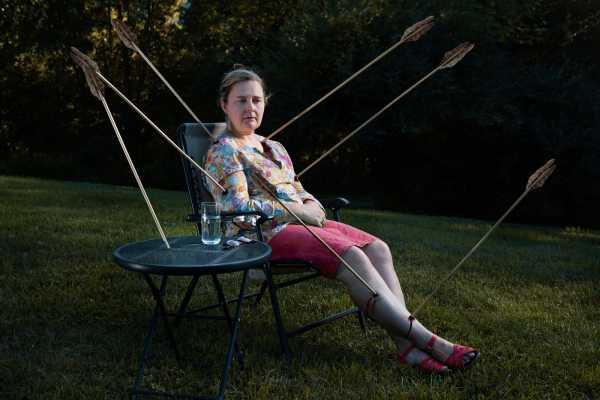
“Nothing Happened Here #19,” 2016.
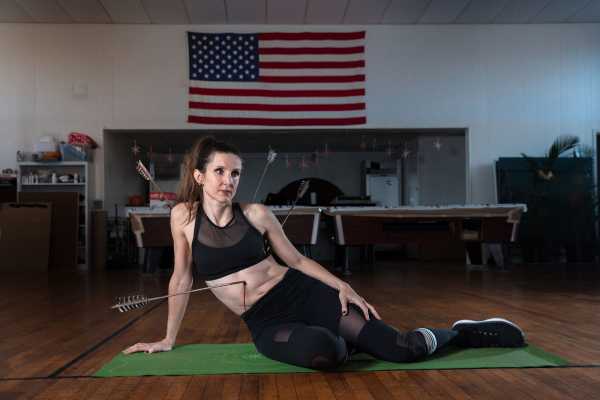
“Nothing Happened Here #16,” 2017.

“Nothing Happened Here #17,” 2017.
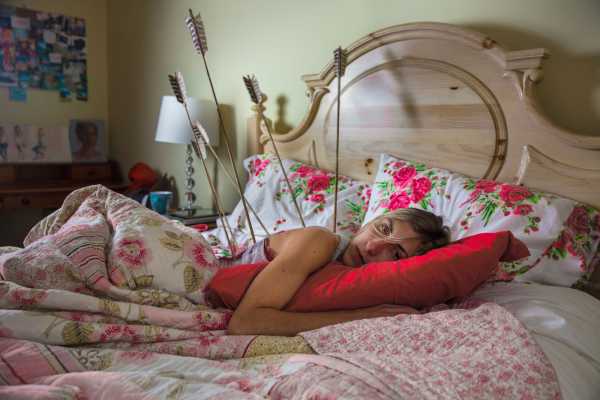
“Nothing Happened Here #13,” 2017.
He had the ideas for both projects in 2017, after reading an article about a Noam Chomsky lecture, headlined “Zombies are the New Indians and Slaves in White America’s Collective Nightmare.” “I guess it was back in 2014, when a random student asked him why America’s students are obsessed with zombie apocalypses,” Dennis told me. During the talk, Chomsky discusses a line in the Declaration of Independence—where King George is accused of inciting the “merciless Indian Savages” against the colonists—and argues that the U.S. exaggerates the power of oppressed minorities, in order to stoke fear and further oppression. “It relates to the idea that we know what we did to them, and that they secretly want to do it to us, which isn’t true,” Dennis said. He laughed at the idea. “Indigenous people only represent two per cent of the population,” he said, “so a lot of us think, with all the frustration and mistreatment historically, we should be uprising and reoccupying the land, but the futility of it is staggering. So this is just a frustrated Native person who staged this work to not get put in jail, or whatever.”
For “Rise” and “Nothing Happened Here,” Dennis creates many of the pictures at various art residencies, approaching other artists, staff, or locals, presenting them with a sketch, and asking them to pose. Later, he uses Adobe Photoshop to add arrows and blood, or to populate the images with Indigenous men in traditional clothing—all of them Dennis, wearing a wig—sometimes one or two but as many as a dozen. “I just make tons of selfies of myself,” he said.
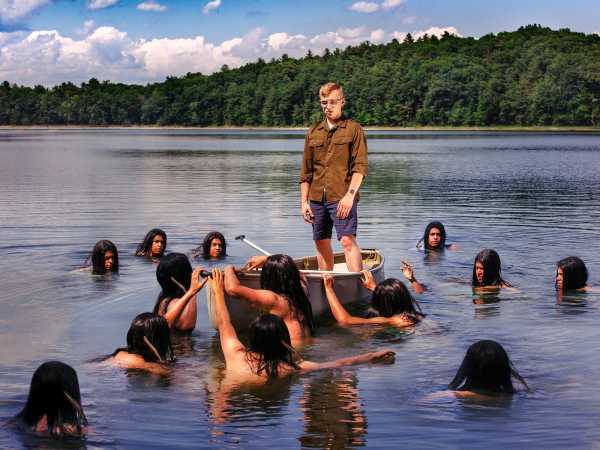
“Wake,” 2018.
One image was made at Yaddo, in 2019. In it, a rowboat is surrounded by men with long, dark hair, rising from the water; a white man, in this case, a barista Dennis met at Saratoga Coffee Traders, in downtown Saratoga Springs, is in the boat. “If I had the technology, I’d immerse myself in soil and be rising in a graveyard to illustrate that,” Dennis said, “but since we’re a coastal people at Shinnecock, I thought it was more practical and made that same parallel—to be emerging from water and coming out of nowhere. In zombie movies, it is the undead haunting the living, and we’re a supposed vanished race, though we never disappeared.”
One photo in the “Rise” series—a woman holding a coffee cup and staring into her pool as a Native American warrior emerges from the chlorinated blue water—was made in Amagansett, after Dennis connected with the homeowner on Instagram. “When I’m not at residences, I usually scroll Instagram too much,” he said. “And sometimes that’s just for art news. Other times, it’s to network. In this case, this woman and her family have a huge art collection in their home, and they just really love art, and I guess she had some free time in the summer, so we ended up staging this image at her property and in the pool. I always like the practical effects of being there physically, even though you could do this on a green screen, I guess.”
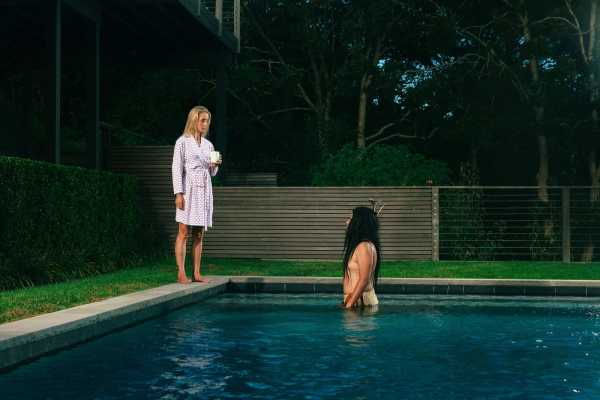
“I Could Stand Here All Night,” 2021, from the series “Rise.”
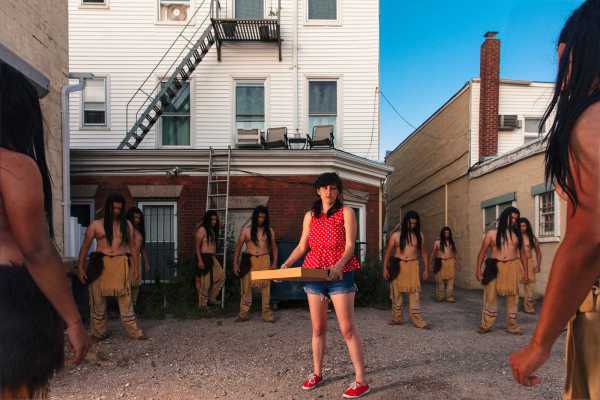
“Pizza Box,” 2018, from the series “Rise.”
The result is a portrait of two different stares, or gazes, in the contemporary parlance. It’s a landscape portrait in the sense that it reveals what’s invisible in the land—namely that the land was taken, that the story of that theft was erased but not entirely, that the erasure was violent, the violence still resonating for everyone in the community. “They are intense and beautiful and ironic,” Lonnie Graham said, of the “Rise” series. “In a way, they are a branch of the ‘On This Site’ project, because here are these ancestors, and they are right there—right there, living with you, whether you like it or not.” Graham sees this kind of work as particular to photography, owing to its almost magical ability to combine detail and fantasy. “Here we are with this device or tool that can manifest these ideas, in fluid forms,” he said. “So, if I want to talk about my past ancestors, I can say, Here they are, right there in your back yard. You’ve built your house on top of them, but they’re coming back to be with you. They never really left. They’ve always been there.”
As Dennis’s drone hovered over Sebonac—storing digital images of the crisp day, the glare off Long Island Sound in the distance, the hills of Connecticut at the edge of the view—I was becoming increasingly nervous about security, but he was serene. He’d been approached before but now was engrossed in picture-making, working quietly. He liked the bird’s-eye view. “The drone makes everything seem unique but connected,” he said. “When I went to New Mexico, the skies were enormous, and you can see for miles and miles, but with all the tree lines here, you can never see more than the length of a football field.”
In a similar way, being with Dennis and thinking about his work helps a person establish new views on the ground. As he packed up the trunk, we looked over at the rolling turf sand traps. “So these would all be our burial grounds,” he said. Willie Dunn, Jr., a Scottish player and designer who expanded the Shinnecock Hills Golf Club from twelve to eighteen holes, boasted of incorporating sacred sites: “The place was dotted with Indian burial grounds, and we left some intact as bunkers in front of the greens. We scraped out some of the mounds and made sand traps. It was here that the Indians buried their empty whiskey barrels, but we did not find this out until later, when playing the golf course. One never knew when an explosion shot in a trap would bring out a couple of firewater flasks, or perhaps a bone or two.”
When Dennis and I got in the car and headed back to the reservation, we crossed over the Shinnecock Hills, and, at one point, as he was talking, Dennis gestured toward everything that the windshield framed. “And so,” he said, “this is all our land.”
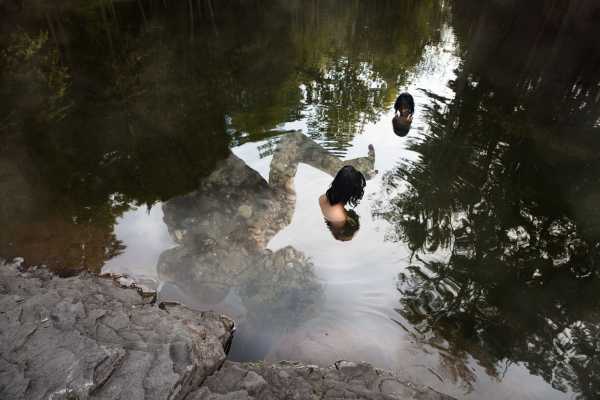
“Glooscap’s Great Leap,” 2017.
Sourse: newyorker.com






